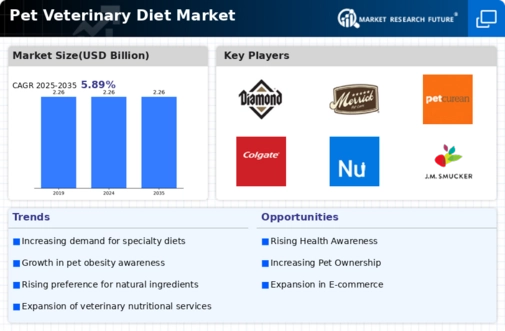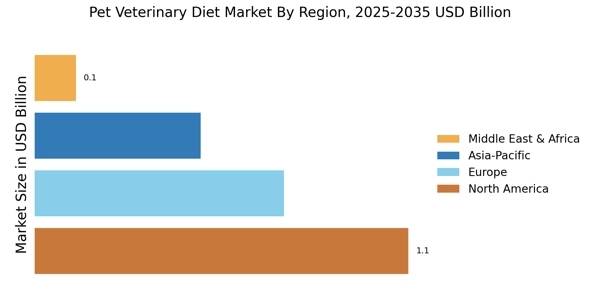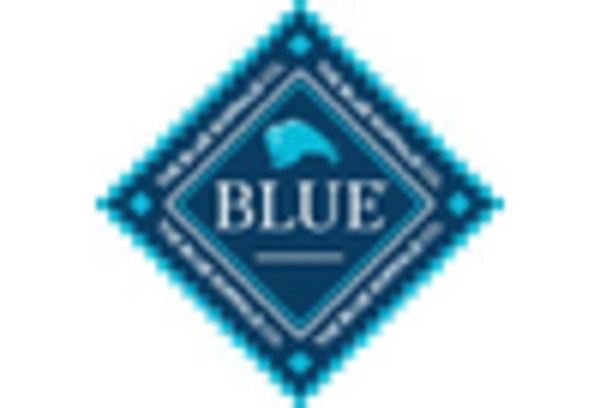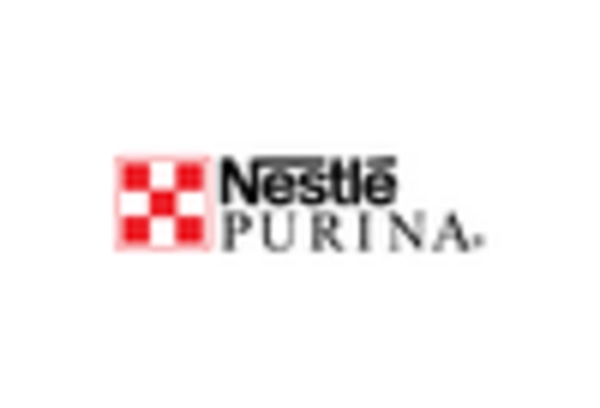Growing Pet Ownership
The increasing trend of pet ownership appears to be a primary driver for the Pet Veterinary Diet Market. As more households adopt pets, the demand for specialized diets tailored to the health needs of these animals intensifies. Recent statistics indicate that pet ownership rates have surged, with approximately 70% of households in certain regions owning at least one pet. This rise in pet ownership correlates with a heightened awareness of pet health, leading to a greater emphasis on veterinary diets. Consequently, pet owners are more inclined to invest in premium dietary options that cater to specific health concerns, such as obesity, allergies, and chronic diseases. This trend suggests that the Pet Veterinary Diet Market is likely to experience sustained growth as pet owners prioritize the well-being of their companions.
Rise of Pet Insurance
The rise of pet insurance is influencing the Pet Veterinary Diet Market by making specialized diets more accessible to pet owners. As more individuals opt for pet insurance, they are likely to seek out veterinary diets that align with their pets' health needs, knowing that these costs may be covered. This trend is particularly relevant for pets with chronic conditions that require ongoing dietary management. Market analysis indicates that the pet insurance sector has seen substantial growth, with many policies now covering dietary needs as part of comprehensive care. This development not only encourages pet owners to invest in veterinary diets but also fosters a culture of preventive care, ultimately benefiting the overall health of pets. The intersection of pet insurance and veterinary diets suggests a synergistic relationship that could enhance the Pet Veterinary Diet Market.
Increased Awareness of Pet Health
There is a notable increase in awareness regarding pet health and nutrition, which significantly influences the Pet Veterinary Diet Market. Pet owners are becoming more educated about the nutritional requirements of their animals, leading to a shift towards specialized veterinary diets. This heightened awareness is often driven by the availability of information through various channels, including veterinary clinics, online resources, and social media. As a result, pet owners are more likely to seek out diets that address specific health issues, such as renal failure or gastrointestinal disorders. Market data suggests that the demand for therapeutic diets has risen, with a substantial portion of pet owners willing to pay a premium for products that promise improved health outcomes. This trend indicates a robust potential for growth within the Pet Veterinary Diet Market.
Advancements in Veterinary Science
Advancements in veterinary science and nutrition are playing a crucial role in shaping the Pet Veterinary Diet Market. Innovations in dietary formulations and a deeper understanding of pet health have led to the development of specialized diets that cater to various medical conditions. For instance, the introduction of novel protein sources and functional ingredients has enhanced the efficacy of veterinary diets. Furthermore, ongoing research into the long-term benefits of specific nutrients is likely to drive demand for these products. As veterinarians increasingly recommend tailored diets for pets with specific health issues, the market for veterinary diets is expected to expand. This trend suggests that the Pet Veterinary Diet Market will continue to evolve, driven by scientific advancements and a commitment to improving pet health.
Regulatory Support for Veterinary Diets
Regulatory support for veterinary diets is emerging as a significant driver in the Pet Veterinary Diet Market. Governments and regulatory bodies are increasingly recognizing the importance of pet nutrition and are establishing guidelines to ensure the safety and efficacy of veterinary diets. This regulatory framework not only enhances consumer confidence but also encourages manufacturers to invest in research and development. As regulations become more stringent, companies are likely to focus on producing high-quality, scientifically-backed products that meet these standards. This shift may lead to an increase in the availability of specialized veterinary diets, further stimulating market growth. The presence of a supportive regulatory environment suggests a promising future for the Pet Veterinary Diet Market.


















Leave a Comment